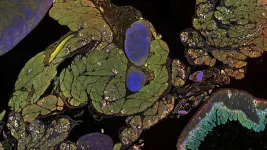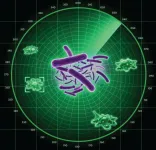(Press-News.org) Pancreatic cancer is projected to become the second-deadliest cancer by 2030. By the time it’s diagnosed, it’s often difficult to treat. So, for both individual patients and the general population, fighting pancreatic cancer can feel like a race against time. Cold Spring Harbor Laboratory (CSHL) Professor and Cancer Center Director David Tuveson offers a telling analogy:
“We all have moles on our skin. Most of your moles are fine. But some of your moles you have a dermatologist looking at to make sure it’s always fine. They may take it out and send it to the pathologist to ask, ‘Is this an early melanoma, a melanoma in situ?’ Now, that’s just what you can see. Imagine that in your pancreas—because that’s the reality. We all have early versions of cancer in many tissues at all times.”
Now imagine treating those “early versions” in the pancreas—before they become cancerous. A new discovery at the CSHL Cancer Center could help make this possible. Tuveson and Research Investigator Claudia Tonelli have found a way to effectively “intercept” pancreatic cancer. To understand how it works, we need to first understand a little bit about pancreatic cancer genetics.
“Over 95% of pancreatic cancer patients have mutations in KRAS,” Tonelli explains. “It’s the driving oncogene in this disease. We discovered that another gene, FGFR2, plays a role in enhancing mutant KRAS signaling in pancreatic cancer. When that happens, those ‘early versions’ of pancreatic cancer become much more aggressive.”
Tonelli and Tuveson observed this outcome in mice and organoids—lab-grown versions of human pancreatic tissue. Of course, the researchers weren’t just having a look. Their goal was to stop the pancreatic tissue from becoming cancerous. Because FGFR2 is a known oncogene in other cancers, several inhibitors are already used in the clinic today.
When Tonelli and her colleagues inhibited FGFR2 at precisely the right moment, they got the results they wanted. Tumor formation slowed significantly. When they targeted FGFR2 along with EGFR—a protein known to be overactive in pancreatic cancer—they saw even better results. Fewer “early versions of cancer” formed in the first place.
“With an increasing number of FGFR2 inhibitors entering the clinic, our study lays the foundation to explore their use in combination with EGFR inhibitors for pancreatic cancer interception,” Tonelli says. Patients with a family history of pancreatic cancer would likely be among the first candidates to receive such treatments.
For now, fighting pancreatic cancer remains a race against time. But with this discovery, the day may soon come when time is on our side.
END
In pancreatic cancer, a race against time
2025-04-02
ELSE PRESS RELEASES FROM THIS DATE:
Targeting FGFR2 may prevent or delay some KRAS-mutated pancreatic cancers
2025-04-02
Bottom Line: Precancerous pancreatic lesions and some pancreatic ductal adenocarcinoma (PDAC) tumors harboring KRAS mutations had higher-than-normal expression of the FGFR2 protein, and FGFR2 inactivation delayed KRAS-mutated PDAC development in mice.
Journal in Which the Study was Published: Cancer Research, a journal of the American Association for Cancer Research
Author: Claudia Tonelli, PhD, a research investigator in the laboratory of AACR Past President David A. Tuveson, MD, PhD, FAACR, at Cold Spring Harbor Laboratory
Background: PDAC is the most common ...
Melodies of musical ‘starquakes’ shed new light on how our galaxy formed
2025-04-02
They say music is the universal language of humankind, but some stars in our galaxy exhibit their own rhythm, offering fresh clues into how they and our galaxy evolved over time.
According to an international team of researchers, including scientists from The Australian National University (ANU) and UNSW Sydney, some stars exhibit fluctuations in their brightness over time, which are caused by continuous ‘starquakes’.
These fluctuations can be translated into frequencies, which can be used to determine a star’s age and other properties ...
Protective radar for bacteria
2025-04-02
Investigation how microorganisms communicate enhances our understanding of the complex ecological interactions that shape our environment – a major focus of the Cluster of Excellence “Balance of the Microverse”. A research team of the Cluster at the Leibniz Institute for Natural Product Research and Infection Biology - Hans Knöll Institute (Leibniz-HKI) and the Friedrich Schiller University, Jena has studied the interaction between amoebae, bacteria, and plants. Researchers from the ...
Increased utilization of overtime and agency nurses and patient safety
2025-04-02
About The Study: The findings of this study suggest that both nurse overtime and nurse agency hours are associated with increased rates of pressure ulcers, a measure that is one of the most sensitive to nursing care. In future research, hospitals could use their own data to track safe thresholds.
Corresponding Author: To contact the corresponding author, Patricia Pittman, PhD, email ppittman@gwu.edu.
To access the embargoed study: Visit our For The Media website at this link https://media.jamanetwork.com/
(doi:10.1001/jamanetworkopen.2025.2875)
Editor’s ...
Spending on glucagon-like peptide-1 receptor agonists among US adults
2025-04-02
About The Study: Spending on glucagon-like peptide-1 receptor agonists (GLP-1 RAs) increased from 2018 to 2023, with the largest growth rates from 2022 to 2023. Although spending for certain GLP-1 RAs increased substantially, spending declined for others. This study estimated that more than $71 billion was spent on GLP-1 RAs and more than $50 billion on a product based on either semaglutide or tirzepatide molecules.
Corresponding Author: To contact the corresponding author, Stavros Tsipas, MA, email stavros.tsipas@ama-assn.org.
To ...
Early-life ozone exposure and asthma and wheeze in children
2025-04-02
About The Study: In this cohort study with relatively low ambient ozone exposure, early-life ozone was associated with asthma and wheeze outcomes at age 4 to 6 and in mixture with other air pollutants but not at age 8 to 9. Regulating and reducing exposure to ambient ozone may help reduce the significant public health burden of asthma among U.S. children.
Corresponding Author: To contact the corresponding author, Logan C. Dearborn, MPH, email dearbl@uw.edu.
To access the embargoed study: Visit our For The Media website at this link https://media.jamanetwork.com/
(doi:10.1001/jamanetworkopen.2025.4121)
Editor’s ...
Early Earth's first crust composition discovery rewrites geological timeline
2025-04-02
Researchers have made a new discovery that changes our understanding of Earth’s early geological history, challenging beliefs about how our continents formed and when plate tectonics began.
A study published in Nature on 2 April reveals that Earth's first crust, formed about 4.5 billion years ago, probably had chemical features remarkably like today’s continental crust.
This suggests the distinctive chemical signature of our continents was established at the very beginning of Earth’s history.
Professor Emeritus Simon ...
Dark diversity reveals global impoverishment of natural vegetation
2025-04-02
A study recently published in Nature indicates that human activities have a negative effect on the biodiversity of wildlife hundreds of kilometres away. A research collaboration led by the University of Tartu assessed the health of ecosystems worldwide, considering both the number of plant species found and the dark diversity – the missing ecologically suitable species.
For the study, over 200 researchers studied plants at nearly 5,500 sites in 119 regions worldwide, including all continents. At each site, they recorded all plant species on 100 m2 and identified the dark diversity – native species that could live there but were absent. ...
Study finds rates of breast and colorectal cancer screening nearly four-fold higher than lung cancer screening among those eligible
2025-04-02
Lung cancer screening has the potential to catch lung cancer early and save lives—but only if people get screened. Although lung cancer screening is recommended in the U.S. for certain individuals with a history of smoking, only 18% of eligible individuals in the U.S. get screened. One suggested explanation has been that those eligible are resistant to receiving preventive healthcare, but a new study published in JAMA and led by researchers at Mass General Brigham indicates otherwise.
Researchers from Mass General Brigham sought to investigate use of other preventive healthcare services among individuals eligible for lung cancer screening. ...
Sound frequencies of stars sing of our galaxy’s past and future
2025-04-02
A new study led by UNSW Sydney researchers into a cluster of stars 2700 light years away reveals their stages of evolution through the ‘sounds’ they make. This discovery will allow scientists to map the history of the Milky Way and other galaxies, accelerating knowledge in the field of astrophysics.
Dr Claudia Reyes is the lead author of the study published today in Nature. While undertaking her PhD at the UNSW School of Physics, she studied 27 stars in a cluster of stars called M67. The stars in ...




